
Table of Contents
- Introduction: The Blueprint for Curb Appeal
- Vision to Reality: Defining Your Goals
- Assessing the Canvas: Evaluating the Site
- Harmonizing Elements: Creating a Cohesive Design
- Crafting Pathways: Guiding the Journey
- Green Spaces: Integrating Nature
- Functional Areas: Balancing Beauty and Utility
- Structural Enhancements: Adding Features
- Lighting the Way: Illuminating Your Design
- Conclusion: Bringing It All Together
Introduction: The Blueprint for Curb Appeal
Crafting an exceptional exterior design requires more than a dash of creativity; it demands a well-thought-out strategy. A meticulously planned exterior not only enhances the aesthetic appeal of a property but also significantly boosts its value. By employing a systematic approach, homeowners and designers can achieve harmony between function and beauty. This guide delves into the essential steps for strategizing exterior design, ensuring that every element, from the landscape to the façade, aligns seamlessly.
Vision to Reality: Defining Your Goals
Every great design starts with a clear vision. Begin by identifying your goals. Are you aiming to boost your home’s curb appeal for a sale, or are you looking to create a personal haven? Understanding your primary objective will guide your design choices.
Once your goals are defined, consider the style that resonates with you. Whether it’s modern minimalism or rustic charm, having a defined style will help narrow down choices and maintain consistency throughout the project. Sketching out ideas or creating a vision board can be particularly helpful in this phase.
Assessing the Canvas: Evaluating the Site
Before diving into design specifics, evaluate your property’s current state. Take note of the strengths and weaknesses of your site. Is there an existing feature, like a grand old tree, that you want to highlight? Conversely, are there unsightly elements that need to be concealed or removed?
Understanding the environmental conditions of your site is crucial. Consider the climate, soil type, and topography. These factors will influence your choice of materials and plants, ensuring that your design is not only beautiful but also sustainable and functional.
Harmonizing Elements: Creating a Cohesive Design
A successful exterior design is more than the sum of its parts. Aim for harmony between the various elements of your property. The architecture of your home should seamlessly blend with the landscape and hardscape features.
Consider the color palette and materials used in your home’s exterior. Ensure that pathways, patios, and garden structures complement the overall aesthetic. The use of a unified theme can tie different areas together, creating a cohesive and visually pleasing design.
Crafting Pathways: Guiding the Journey
Pathways are more than just functional elements; they guide visitors through your space and set the tone for the overall design. When designing pathways, consider the flow and movement throughout your property.
Select materials that complement your home’s exterior. Stone, brick, or gravel can add texture and interest. Additionally, consider incorporating lighting along pathways. Not only does this enhance safety, but it also creates a welcoming ambiance during the evening hours.
Green Spaces: Integrating Nature
Incorporating greenery is essential in exterior design. Plants bring life and color, enhancing the aesthetic appeal while providing environmental benefits. Start by selecting plants that are native to your area. Native plants are typically more resilient and require less maintenance.
Design your garden with a variety of plant types, including trees, shrubs, and flowers. This diversity adds depth and interest to your landscape. Pay attention to the seasonal changes of your plants to ensure year-round beauty. Consider layering plants to create a lush, dynamic landscape.


Functional Areas: Balancing Beauty and Utility
A well-planned exterior design balances beauty with functionality. Identify areas that need to serve specific purposes, such as seating areas, play zones, or outdoor kitchens. Design these spaces to be both attractive and practical.
Incorporate durable materials that can withstand the elements. For seating areas, comfortable and weather-resistant furniture is key. In outdoor kitchens, use materials like stainless steel that are easy to clean and maintain. Ensure that these functional areas are integrated seamlessly into the overall design.
Structural Enhancements: Adding Features
Structural elements can significantly enhance the appeal of your exterior design. Consider adding features like pergolas, gazebos, or trellises. These structures not only provide shade and comfort but also create focal points within your landscape.
When choosing materials for these structures, ensure they complement your home’s exterior. Wood, metal, and composite materials each offer distinct aesthetic and functional benefits. Additionally, think about incorporating climbing plants or vines to soften these structures and blend them into the natural environment.
Lighting the Way: Illuminating Your Design
Effective lighting design can transform your exterior space, adding drama and safety. Begin by identifying key areas that require illumination, such as pathways, entrances, and seating areas. Use a mix of lighting types to create a balanced and inviting atmosphere.
Accent lighting can highlight architectural features or specific plants, adding depth to your design. Solar-powered lights are an eco-friendly option that can reduce energy costs. Ensure that your lighting plan enhances both the functionality and aesthetics of your exterior space.
Conclusion: Bringing It All Together
Strategizing exterior design with a plan is a comprehensive process that involves careful consideration of various elements. From defining your vision to selecting materials and plants, each step plays a crucial role in creating a cohesive and appealing design. By following these guidelines, you can transform your exterior space into a beautiful, functional, and sustainable environment. Remember, a well-designed exterior not only enhances your home’s value but also creates a welcoming and enjoyable space for you and your guests.


